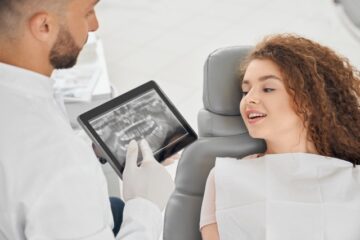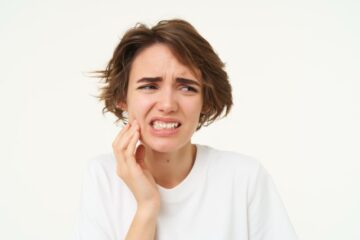When and How to Use Mouthwash for Optimal Oral Health

Contents

Should I use mouthwash or not? That is the question. All dentists of today will answer it with a chorus – Of course, yes! The fact is that the use of various mouthwashes for oral health is not a new trend. Even Hippocrates advised rinsing your mouth after meals with a solution of salt, alum and vinegar to take care of your smile’s health.
These days, mouthwashes are used to care for healthy teeth and gums. Chances are you have one of these products in your home. And if your mouthwash is sitting idle, it’s a sign to you that it’s time to use it regularly. Here’s why you need it, why mouthwash is a must-have for a healthy and beautiful smile, and how to use mouthwash.
What is a Mouthwash?
Every day, every minute and perhaps every second, bacteria in the oral cavity do not sleep, but multiply. They form in the mouth because of leftover food particles and immediately build “sandcastles” in the form of plaque on teeth, tongue, cheeks, gums. And we know that nothing does a better job of dealing with real sandcastles (that you build with your kids while on vacation) than sea or ocean tides. In the case of oral care, however, it’s mouthwashes that play the role of the tides that wash everything away. They wash away plaque, taking care of the health of your teeth and gums.
If you take away all the metaphors, a mouthwash is an oral hygiene liquid with antiseptic and refreshing action. These products are recommended for home oral hygiene along with daily use of toothbrush, toothpaste and floss.
How Does Mouthwash Work?
Mouthwashes typically contain antiseptics, such as alcohol or hydrogen peroxide, to eliminate oral microbes. Depending on the type of rinse, additional key ingredients may include:
Also, depending on the type of rinse and its key property in the composition of the remedy can be:
- Alcohol or hydrogen peroxide for antimicrobial and antibacterial effects.
- Fluoride to strengthen tooth enamel.
- Plant extracts like chamomile for soothing and anti-inflammatory properties.
- Essential oils with menthol for a refreshing sensation.
Benefits of mouthwash you need to know:
- Removes bacterial plaque.
- Prevents tooth decay.
- Reduces the risk of gum inflammation (gingivitis).
- Strengthens enamel (if fluoride is present).
- Freshens breath.
When to Use Mouthwash
A rinse aid in the morning and evening is a must-have
The best way to use mouthwash is morning and evening brushing. Use it during your morning and evening oral hygiene routine without fail. However, it is important to do it in a certain sequence: first floss, then brush your teeth and only after that use mouthwash.
Can I use the product during the day?
You can use mouthwash after meals or between meals to freshen your breath. However, for maximum effectiveness, it’s best to use it after brushing and flossing in your morning and evening routines. In the next section, we’ll provide more detailed guidance on when and how to use mouthwash correctly.
How to Use Mouthwash Properly
Step 1. Use a flosser
Flossing is crucial for removing food debris from between teeth, along the gumline, and under the gumline — areas where a toothbrush alone cannot reach. This ensures a thorough cleaning and clears any obstacles in the path of the mouthwash. By flossing beforehand, you allow the rinse to effectively target not only the front surfaces of your teeth and gums but also the spaces between your teeth and gum areas.
Step 2. Brush your teeth
Before using the rinse, it’s essential to brush your teeth with toothpaste to remove plaque and food debris from the tooth surfaces. Afterwards, rinse your mouth thoroughly with water to remove any residual toothpaste.
Step 3. Fill a measuring cup with rinse aid
Use a rinse cap or a personal liquid cup to measure out a small amount of mouthwash. Adjust the quantity based on your preference and how you feel.
Step 4. Rinse your mouth
Pour the desired amount of mouthwash into the rinse cup—either a full or half cup. Swish the liquid between your teeth, ensuring it reaches all areas of your mouth: the top, left, right, and bottom, including your tongue. Aim to cover the entire surface of your teeth and gums on both the upper and lower jaw.
You can complete this in one or two rinses. For the latter option, use half of the measured amount to rinse your upper jaw, then spit it out. Next, pour the remaining mouthwash into your mouth and rinse your lower jaw and tongue before spitting it out. If you’ve followed these steps, great job!
Step 5. Do I need to rinse my mouth with water afterward?
There’s no need to rinse your mouth with water after using the mouthwash. Leaving the refreshing taste in your mouth is perfectly fine.
Incorporate the rinse into your morning and evening routines for best results. You’ll notice an improvement in the bacterial environment of your mouth, especially after evening use. In the morning, you’ll find less plaque buildup on your teeth compared to nights when you don’t use the product.
Additional Tips for Mouthwash Use to Get More Benefits
- How long to swish mouthwash? An important point worth mentioning. Rinse your mouth with mouthwash for at least 25-30 seconds. This will be enough time for the product to work as it should.
- Use mouthwash not only after brushing but also throughout the day, especially after meals, if necessary, to freshen your breath and eliminate bacteria.
- If you’re pouring mouthwash directly from the cap or bottle, consider it your personal oral hygiene tool, akin to a toothbrush. Despite its antiseptic properties, there may still be saliva and germs on the cap’s rim.
And lastly, we note that using a mouthwash is your contribution to the health of your teeth and gums. Use your dentist’s recommendation in choosing the right tooth rinse option for you. Your dentist will help you choose the best product with a good composition based on your indications and preferences.
We also advise scheduling regular professional dental cleanings to remove hardened plaque and prevent tooth decay. At our clinic, we can recommend an appropriate mouthwash and provide preventive dental cleanings to safeguard against tooth and gum diseases.
How to Use Mouthwash: the Most Common Questions
Does Mouthwash Prevent Plaque?
Yes, the main property of rinses is to remove germs and bacteria in the oral cavity, which just form soft and fossilized plaque. Therefore, daily use of such products can prevent the appearance of dental plaque.
Is it Better to Use Mouthwash Before or After Brushing?
The ideal regimen for cleaning your mouth at home is to use a flosser, then brush your teeth with a toothbrush and only then should you use a mouthwash.
Can I Swallow My Saliva After Mouthwash?
No, most dentists and manufacturers recommend spitting the rinse out after use rather than swallowing it. Read the recommendations for use of your chosen rinse aid on the package.
Can I Gargle Mouthwash?
Yes, mouthwashes can be used as a gargle to remove germs and bacteria.
Additional Resources
Mouthwash – American Dental Association
Bad Breath 6 Causes (and 6 Solutions) – American Dental Association













